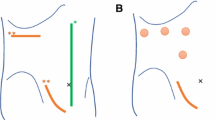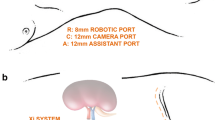Abstract
Purpose
To evaluate the effect of lymphadenectomy (LND) in conjunction with nephroureterectomy on cancer-specific mortality (CSM) and overall survival (OS) for patients with muscle-invasive UTUC.
Methods
A retrospective, multicenter study of patients with UTUC, clinical stage N0M0, who underwent nephroureterectomy between January 2008 and December 2014 was conducted. Outcome measures were OS and CSM.
Results
In total, 298 patients underwent robot-assisted or laparoscopic radical nephroureterectomy with a final histological diagnosis of UTUC. LND was performed in 46 (15.4%). One hundred and seventy-two patients (62%) had non-muscle-invasive disease (NMID); 105 patients (38%) had muscle-invasive disease (MID). Median time of follow-up was 43.5 months (95% CI 36.0–47.2). For patients with MID, the 5-year cumulative incidence of all-cause mortality and CSM was 73.5% (95% CI 60.4–86.6) and 52.4% (95% CI 38.9–65.9), respectively (p < 0.0001). There was no significant difference in OS between patients with N1 and patients with N0 disease (p = 0.53). The 5-year OS rates were 30.5% (95% CI 6.6–54.4) and 25.7% (95% CI 10.9–40.5), respectively. This study is limited by its retrospective nature. There may also have been bias in the selection of patients undergoing LND.
Conclusions
Five-year OS and CSM are comparable between patients with N1 and N0 MID. This evidence may support the use of the LND procedure in patients with muscle-invasive UTUC.



Similar content being viewed by others
Abbreviations
- UTUC:
-
Upper urinary tract urothelial carcinoma
- LND:
-
Extended lymphadenectomy
- OS:
-
Overall survival
- CSM:
-
Cancer-specific mortality
- CT:
-
Computed tomography
- pN1:
-
Lymph nodes with malignant cells
- RR:
-
Relative risks
- HRs:
-
Hazard ratios
- CI:
-
Confidence interval
References
Soria F, Shariat SF, Lerner SP et al (2017) Epidemiology, diagnosis, preoperative evaluation and prognostic assessment of upper-tract urothelial carcinoma (UTUC). World J Urol 35(3):379–387
Holmäng S, Johansson SL (2006) Bilateral metachronous ureteral and renal pelvic carcinomas: incidence, clinical presentation, histopathology, treatment and outcome. J Urol 175(1):69–72 discussion 72–63
Hall MC, Womack S, Sagalowsky AI et al (1998) Prognostic factors, recurrence, and survival in transitional cell carcinoma of the upper urinary tract: a 30-year experience in 252 patients. Urology 52(4):594–601
Olgac S, Mazumdar M, Dalbagni G, Reuter VE (2004) Urothelial carcinoma of the renal pelvis: a clinicopathologic study of 130 cases. Am J Surg Pathol 28(12):1545–1552
Dhar NB, Klein EA, Reuther AM, Thalmann GN, Madersbacher S, Studer UE (2008) Outcome after radical cystectomy with limited or extended pelvic lymph node dissection. J Urol 179(3):873–878 discussion 878
Madersbacher S, Hochreiter W, Burkhard F et al (2003) Radical cystectomy for bladder cancer today—a homogeneous series without neoadjuvant therapy. J Clin Oncol 21(4):690–696
Stein JP, Lieskovsky G, Cote R et al (2001) Radical cystectomy in the treatment of invasive bladder cancer: long-term results in 1054 patients. J Clin Oncol 19(3):666–675
Lughezzani G, Jeldres C, Isbarn H et al (2010) A critical appraisal of the value of lymph node dissection at nephroureterectomy for upper tract urothelial carcinoma. Urology 75(1):118–124
Kondo T, Nakazawa H, Ito F, Hashimoto Y, Toma H, Tanabe K (2007) Primary site and incidence of lymph node metastases in urothelial carcinoma of upper urinary tract. Urology 69(2):265–269
Kondo T, Hara I, Takagi T et al (2014) Template-based lymphadenectomy in urothelial carcinoma of the renal pelvis: a prospective study. Int J Urol 21(5):453–459
Kondo T, Hara I, Takagi T et al (2014) Possible role of template-based lymphadenectomy in reducing the risk of regional node recurrence after nephroureterectomy in patients with renal pelvic cancer. Jpn J Clin Oncol 44(12):1233–1238
Tanaka N, Kikuchi E, Kanao K et al (2014) Metastatic behavior of upper tract urothelial carcinoma after radical nephroureterectomy: association with primary tumor location. Ann Surg Oncol 21(3):1038–1045
Dindo D, Demartines N, Clavien PA (2004) Classification of surgical complications: a new proposal with evaluation in a cohort of 6336 patients and results of a survey. Ann Surg 240(2):205–213
Gray RJ (1988) A class of K-sample tests for comparing the cumulative incidence of a competing risk. Annal Stat 16(3):1141–1154
Matin SF, Margulis V, Kamat A et al (2010) Incidence of downstaging and complete remission after neoadjuvant chemotherapy for high-risk upper tract transitional cell carcinoma. Cancer 116(13):3127–3134
Birtle AJ, Lewis R, Johnson M, Hall E (2012) (TMG) PTMG: time to define an international standard of postoperative care for resected upper urinary tract transitional cell carcinoma (TCC)—opening of the peri-operative chemotherapy versus surveillance in upper tract urothelial cancer (POUT) Trial. BJU Int 110(7):919–921
Jensen TK, Holt P, Gerke O et al (2011) Preoperative lymph-node staging of invasive urothelial bladder cancer with 18F-fluorodeoxyglucose positron emission tomography/computed axial tomography and magnetic resonance imaging: correlation with histopathology. Scand J Urol Nephrol 45(2):122–128
Tanaka H, Yoshida S, Komai Y et al (2016) Clinical value of 18F-fluorodeoxyglucose positron emission tomography/computed tomography in upper tract urothelial carcinoma: impact on detection of metastases and patient management. Urol Int 96(1):65–72
Author information
Authors and Affiliations
Corresponding author
Rights and permissions
About this article
Cite this article
Azawi, N.H., Berg, K.D., Thamsborg, A.K.M. et al. Laparoscopic and robotic nephroureterectomy: does lymphadenectomy have an impact on the clinical outcome?. Int Urol Nephrol 49, 1785–1792 (2017). https://doi.org/10.1007/s11255-017-1672-1
Received:
Accepted:
Published:
Issue Date:
DOI: https://doi.org/10.1007/s11255-017-1672-1




